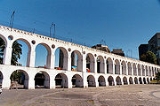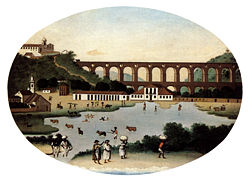
Carioca Aqueduct
Encyclopedia

Aqueduct
An aqueduct is a water supply or navigable channel constructed to convey water. In modern engineering, the term is used for any system of pipes, ditches, canals, tunnels, and other structures used for this purpose....
in the city of Rio de Janeiro
Rio de Janeiro
Rio de Janeiro , commonly referred to simply as Rio, is the capital city of the State of Rio de Janeiro, the second largest city of Brazil, and the third largest metropolitan area and agglomeration in South America, boasting approximately 6.3 million people within the city proper, making it the 6th...
, Brazil
Brazil
Brazil , officially the Federative Republic of Brazil , is the largest country in South America. It is the world's fifth largest country, both by geographical area and by population with over 192 million people...
. The aqueduct was built in the middle of the 18th century to bring fresh water from the Carioca river to the population of the city. It is an impressive example of colonial architecture
Architecture
Architecture is both the process and product of planning, designing and construction. Architectural works, in the material form of buildings, are often perceived as cultural and political symbols and as works of art...
and engineering
Engineering
Engineering is the discipline, art, skill and profession of acquiring and applying scientific, mathematical, economic, social, and practical knowledge, in order to design and build structures, machines, devices, systems, materials and processes that safely realize improvements to the lives of...
.
The Carioca Aqueduct is located in the centre of the city, in the Lapa neighbourhood
Lapa (Rio de Janeiro)
Lapa is a neighbourhood in the city of Rio de Janeiro, in Brazil. It is located in the centre of Rio and is famous for its historical monuments and nightlife....
, and is frequently called Arcos da Lapa (Lapa Arches) by Brazilian people. Since the end of the 19th century the aqueduct serves as a bridge for a popular tram
Tram
A tram is a passenger rail vehicle which runs on tracks along public urban streets and also sometimes on separate rights of way. It may also run between cities and/or towns , and/or partially grade separated even in the cities...
that connects the city centre with the Santa Teresa neighbourhood
Santa Teresa (Rio de Janeiro)
Santa Teresa is the name of a neighbourhood in the city of Rio de Janeiro, Brazil. It is located on top of the Santa Teresa hill, by the centre of Rio, and is famous for its winding, narrow streets which are a favourite spot for artists and tourists....
uphill, the Santa Teresa Tramway.
History
In the early history of Rio de Janeiro, the nucleus of the city was surrounded by swampSwamp
A swamp is a wetland with some flooding of large areas of land by shallow bodies of water. A swamp generally has a large number of hammocks, or dry-land protrusions, covered by aquatic vegetation, or vegetation that tolerates periodical inundation. The two main types of swamp are "true" or swamp...
s with water of bad quality, and fresh water
Fresh Water
Fresh Water is the debut album by Australian rock and blues singer Alison McCallum, released in 1972. Rare for an Australian artist at the time, it came in a gatefold sleeve...
had to be carried manually from streams located relatively far from the city. Since at least 1602 there had been plans to build a system of canal
Canal
Canals are man-made channels for water. There are two types of canal:#Waterways: navigable transportation canals used for carrying ships and boats shipping goods and conveying people, further subdivided into two kinds:...
s to bring water from the source
Source (river or stream)
The source or headwaters of a river or stream is the place from which the water in the river or stream originates.-Definition:There is no universally agreed upon definition for determining a stream's source...
of the Carioca river, located on Santa Teresa hill, to Rio de Janeiro. Colonial authorities
Colonial Brazil
In the history of Brazil, Colonial Brazil, officially the Viceroyalty of Brazil comprises the period from 1500, with the arrival of the Portuguese, until 1815, when Brazil was elevated to kingdom alongside Portugal as the United Kingdom of Portugal, Brazil and the Algarves.During the over 300 years...
attempted to build canals, but the construction was always hampered by technical and financial difficulties. By the end of the 17th century there were only a few hundred metres of canalisation completed.

Cinelândia
Cinelândia is the popular name of a major public square in the centre of Rio de Janeiro, Brazil. Its official name is Praça Floriano Peixoto, in honour of the second president of Brazil, Floriano Peixoto.-History:...
), should reach the Santo Antônio square (today's Largo da Carioca), which was closer to the centre of the city. Construction of the first aqueduct was finished in 1723, and clean water flowed directly to a decorative Baroque
Baroque
The Baroque is a period and the style that used exaggerated motion and clear, easily interpreted detail to produce drama, tension, exuberance, and grandeur in sculpture, painting, literature, dance, and music...
fountain
Fountain
A fountain is a piece of architecture which pours water into a basin or jets it into the air either to supply drinking water or for decorative or dramatic effect....
in Santo Antônio Square, to the relief of the people of Rio de Janeiro.
This first aqueduct was already in bad shape by 1744, when governor Gomes Freire de Andrade (1733–1763) ordered the building of a new, larger structure. The works were encharged to Portuguese
Portuguese Empire
The Portuguese Empire , also known as the Portuguese Overseas Empire or the Portuguese Colonial Empire , was the first global empire in history...
military engineer José Fernandes Pinto Alpoim, who was inspired by similar structures in Portugal
Portugal
Portugal , officially the Portuguese Republic is a country situated in southwestern Europe on the Iberian Peninsula. Portugal is the westernmost country of Europe, and is bordered by the Atlantic Ocean to the West and South and by Spain to the North and East. The Atlantic archipelagos of the...
, like the Águas Livres Aqueduct
Águas Livres Aqueduct
The Águas Livres Aqueduct is a historic aqueduct in the city of Lisbon, Portugal. It is one of the most remarkable examples of 18th-century Portuguese engineering...
in Lisbon
Lisbon
Lisbon is the capital city and largest city of Portugal with a population of 545,245 within its administrative limits on a land area of . The urban area of Lisbon extends beyond the administrative city limits with a population of 3 million on an area of , making it the 9th most populous urban...
. The aqueduct was inaugurated in 1750.

In colonial times, water from the Carioca Aqueduct reached several fountains scattered through Rio de Janeiro, including those in Santo Antônio Square, Ajuda Square (Cinelândia
Cinelândia
Cinelândia is the popular name of a major public square in the centre of Rio de Janeiro, Brazil. Its official name is Praça Floriano Peixoto, in honour of the second president of Brazil, Floriano Peixoto.-History:...
) and the Terreiro do Paço (today's Praça XV). At the end of the 18th century, as the waters of the Carioca river were insufficient to feed the aqueduct, water from other streams were also derived to its canals.
Tramway
The aqueduct was deactivated at the end of the 19th century, as new alternatives to supply water to Rio were developed. The arches were adapted in 1896 to serve as a bridge for a tramTram
A tram is a passenger rail vehicle which runs on tracks along public urban streets and also sometimes on separate rights of way. It may also run between cities and/or towns , and/or partially grade separated even in the cities...
- the Bondinho de Santa Teresa (Santa Teresa Tramway) - that transports passengers between the centre of Rio and the hilly Santa Teresa neighbourhood. The picturesque ride is popular among locals and tourists alike. The Santa Teresa bondinho is the only tram still in use in Rio de Janeiro.
In the 1960s, several houses that had been built near the aqueduct were demolished, improving the visual impact of the monument.


